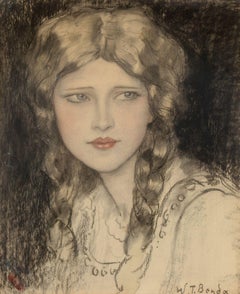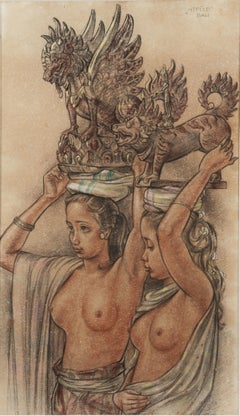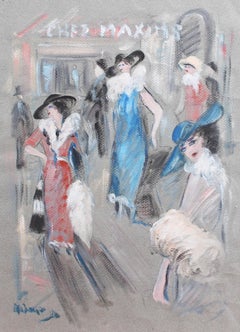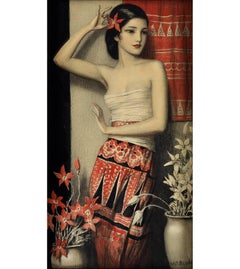Wladyslaw T. Benda Art
to
2
2
2
2
Overall Height
to
Overall Width
to
2
2
2
2
1
2
1
2
6,886
3,210
2,514
1,217
2
2
2
2
2
Artist: Wladyslaw T. Benda
Girl with Braids
By Wladyslaw T. Benda
Located in Fort Washington, PA
Medium: Charcoal, Pastel, and Watercolor on Board
Signature: Signed Lower Right
Sight Size 18.75" x 15.25;" Framed 27.50" x 15.25"
circa 1920
Girl with Braids...
Category
1920s Wladyslaw T. Benda Art
Materials
Charcoal, Pastel, Watercolor, Board
Daydreams
By Wladyslaw T. Benda
Located in Fort Washington, PA
Medium: Charcoal, Pastel, and Watercolor on Board
Signature: Signed Lower Right
Sight Size 16.00;" Framed 28.00" x 25.00"
Category
20th Century Wladyslaw T. Benda Art
Materials
Charcoal, Pastel, Watercolor, Board
Related Items
Two Balinese Beauties (Mapeed), circa 1945
By Johan Rudolf Bonnet
Located in Amsterdam, NL
Rudolf Bonnet (1895-1978)
'Mepèèd' (Mapeed)
Signed lower right
Titled upper right
Pastel on gouache pigmented paper, 57 x 34 cm
In original carved ebo...
Category
1940s Wladyslaw T. Benda Art
Materials
Paper, Crayon, Pastel, Gouache, Pencil
Free Shipping
H 22.45 in W 13.39 in D 0.04 in
Chez Maxim's
By André Meurice
Located in London, GB
'Chez Maxim's', pastel and gouache on fine art paper, by André Meurice (circa 1950s - 60s). The artist depicts the glamorous clientele at the entryway to...
Category
Mid-20th Century Art Nouveau Wladyslaw T. Benda Art
Materials
Pastel, Gouache
18th century pastel portrait of Lady Augusta Corbett and her son, Stuart
By Daniel Gardner
Located in London, GB
Collections:
Commissioned by Andrew Corbett, husband of the sitter;
The Venerable Stuart Corbett;
Sir Stuart Corbett;
By descent to 2002;
Sotheby’s, London 21 March 2002, lot.104;
Lowell Libson...
Category
18th Century Old Masters Wladyslaw T. Benda Art
Materials
Gouache, Pastel
Portraits of the Hon. Mary Shuttleworth and Anna Maria, 9th Baroness Forrester
By Daniel Gardner
Located in London, GB
THE HON. MARY SHUTTLEWORTH, NÉE COCKBURN (D. 1777)
and her sister
ANNA MARIA, 9TH BARONESS FORRESTER (D. 1808)
Pastel and gouache on paper laid on canvas, on their original backb...
Category
18th Century Old Masters Wladyslaw T. Benda Art
Materials
Gouache, Pastel
Rare Modernist Hungarian Rabbi Pastel Drawing Gouache Painting Judaica Art Deco
By Hugó Scheiber
Located in Surfside, FL
Rabbi in the synagogue at prayer wearing tallit and tefillin.
Hugó Scheiber (born 29 September 1873 in Budapest – died there 7 March 1950) was a Hungarian modernist painter.
Hugo Scheiber was brought from Budapest to Vienna at the age of eight where his father worked as a sign painter for the Prater Theater. At fifteen, he returned with his family to Budapest and began working during the day to help support them and attending painting classes at the School of Design in the evening, where Henrik Papp was one of his teachers. He completed his studies in 1900. His work was at first in a post-Impressionistic style but from 1910 onward showed his increasing interest in German Expressionism and Futurism. This made it of little interest to the conservative Hungarian art establishment.
However, in 1915 he met the great Italian avant-gardist Filippo Tommaso Marinetti and the two painters became close friends. Marinetti invited him to join the Futurist Movement. The uniquely modernist style that he developed was, however, closer to German Expressionism than to Futurism and eventually drifted toward an international art deco manner similar to Erté's. In 1919, he and his friend Béla Kádar held an exhibition at the Hevesy Salon in Vienna. It was a great success and at last caused the Budapest Art Museum to acquire some of Scheiber's drawings. Encouraged, Scheiber came back to live in Vienna in 1920.
A turning point in Scheiber's career came a year later, when Herwarth Walden, founder of Germany's leading avant-garde periodical, Der Sturm, and of the Sturm Gallery in Berlin, became interested in Scheiber's work. Scheiber moved to Berlin in 1922, and his paintings soon appeared regularly in Walden's magazine and elsewhere. Exhibitions of his work followed in London, Rome, La Paz, and New York.
Scheiber's move to Germany coincided with a significant exodus of Hungarian artists to Berlin, including Laszlo Moholy-Nagy and Sandor Bortnyik. There had been a major split in ideology among the Hungarian avant-garde. The Constructivist and leader of the Hungarian avantgarde, Lajos Kassák (painted by Hugó Scheiber in 1930) believed that art should relate to all the needs of contemporary humankind. Thus he refused to compromise the purity of his style to reflect the demands of either the ruling class or socialists and communists. The other camp believed that an artist should be a figurehead for social and political change.
The fall out and factions that resulted from this politicisation resulted in most of the Hungarian avant gardists leaving Vienna for Berlin. Hungarian émigrés made up one of the largest minority groups in the German capital and the influx of their painters had a significant effect on Hungarian and international art. Another turning point of Scheiber's career came in 1926, with the New York exhibition of the Société Anonyme, organized by Katherine Dreier. Scheiber and other important avant garde artists from more than twenty-three countries were represented. In 1933, Scheiber was invited by Marinetti to participate in the great meeting of the Futurists held in Rome in late April 1933, Mostra Nazionale d’Arte Futurista where he was received with great enthusiasm. Gradually, the Hungarian artists began to return home, particularly with the rise of Nazism in Germany. Kádar went back from Berlin in about 1932 and Scheiber followed in 1934.
He was then at the peak of his powers and had a special flair in depicting café and cabaret life in vivid colors, sturdily abstracted forms and spontaneous brush strokes. Scheiber depicted cosmopolitan modern life using stylized shapes and expressive colors. His preferred subjects were cabaret and street scenes, jazz musicians, flappers, and a series of self-portraits (usually with a cigar). his principal media being gouache and oil. He was a member of the prestigious New Society of Artists (KUT—Képzőművészek Új Társasága)and seems to have weathered Hungary's post–World War II transition to state-communism without difficulty. He continued to be well regarded, eventually even receiving the posthumous honor of having one of his images used for a Russian Soviet postage stamp (see image above). Hugó Scheiber died in Budapest in 1950.
Paintings by Hugó Scheiber form part of permanent museum collections in Budapest (Hungarian National Museum), Pecs (Jannus Pannonius Museum), Vienna, New York, Bern and elsewhere. His work has also been shown in many important exhibitions, including:
"The Nell Walden Collection," Kunsthaus Zürich (1945)
"Collection of the Société Anonyme," Yale University Art Gallery, New Haven, Connecticut (1950)
"Hugó Scheiber: A Commemorative Exhibition," Hungarian National Museum, Budapest (1964)
"Ungarische Avantgarde," Galleria del Levante, Munich (1971)
"Paris-Berlin 1900-1930," Centre Georges Pompidou, Paris (1978)
"L’Art en Hongrie, 1905-1920," Musée d’Art et l’Industrie, Saint-Etienne (1980)
"Ungarische Avantgarde in der Weimarer Republik," Marburg (1986)
"Modernizmus," Eresz & Maklary Gallery, Budapest (2006)
"Hugó Scheiber & Béla Kádár," Galerie le Minotaure, Paris and Tel Aviv (2007)
Hugó Scheiber's paintings continue to be regularly sold at Sotheby's, Christie's, Gillen's Arts (London), Papillon Gallery (Los Angeles) and other auction houses.
He was included in the exhibition The Art Of Modern Hungary 1931 and other exhibitions along with Vilmos Novak Aba, Count Julius Batthyany, Pal Bor, Bela Buky, Denes Csanky, Istvan Csok, Bela Czobel, Peter Di Gabor, Bela Ivanyi Grunwald, Baron Ferenc Hatvany, Lipot Herman, Odon Marffy, C. Pal Molnar...
Category
Early 20th Century Modern Wladyslaw T. Benda Art
Materials
Paper, Charcoal, Pastel, Watercolor, Gouache
Pastel, Ink Drawing Rocks And Cloud Landscape Jewish American Modernist WPA
By Ben-Zion Weinman
Located in Surfside, FL
Miniature Landscape
Provenance: Virginia Field, Arts administrator; New York, N.Y. Assistant director for Asia House gallery. (she was friends with John von Wicht and Andy Warhol)
Born in 1897, Ben-Zion Weinman celebrated his European Jewish heritage in his visual works as a sculptor, painter, and printmaker. Influenced by Spinoza, Knut Hamsun, and Wladyslaw Reymont, as well as Hebrew literature, Ben-Zion wrote poetry and essays that, like his visual work, attempt to reveal the deep “connection between man and the divine, and between man and earth.”
An emigrant from the Ukraine, he came to the US in 1920. He wrote fairy tales and poems in Hebrew under the name Benzion Weinman, but when he began painting he dropped his last name and hyphenated his first, saying an artist needed only one name.
Ben-Zion was a founding member of “The Ten: An Independent Group” The Ten” a 1930’s avant-garde group, Painted on anything handy. Ben-Zion often used cabinet doors (panels) in his work. Other members of group included Ilya Bolotowsky, Lee Gatch, Adolf Gottlieb, Louis Harris, Yankel Kufeld, Marcus Rothkowitz (later known as Mark Rothko), Louis Schanker, and Joseph Solman. The Art of “The Ten” was generally described as expressionist, as this style offered the best link between modernism and social art. Their exhibition at the Mercury Gallery in New York held at the same time as the Whitney Annual Exhibition of Contemporary American Painting, included a manifesto concentrating on aesthetic questions and criticisms of the conservative definition of modern art imposed by the Whitney. Ben-Zion’s work was quickly noticed. The New York Sun said he painted “furiously” and called him “the farthest along of the lot.” And the triptych, “The Glory of War,” was described by Art News as “resounding.”
By 1939, The Ten disbanded because most of the members found individual galleries to represent their work. Ben-Zion had his first one-man show at the Artist’s Gallery in Greenwich Village and J.B. Neumann, the highly esteemed European art dealer who introduced Paul Klee, (among others) to America, purchased several of Ben-Zion’s drawings. Curt Valentin, another well-known dealer, exhibited groups of his drawings and undertook the printing of four portfolios of etchings, each composed of Ben-Zion’s biblical themes.
Ben-Zion’s work is represented in many museums throughout the country including the Metropolitan, the Whitney, and the Museum of Modern Art in New York, the Art Institute of Chicago, the Philadelphia Museum of Art and the Phillips Collection, Washington. The Jewish Museum in New York opened in 1948 with a Ben-Zion exhibition.
“Ben-Zion has his hands on the pulse of the common man and his natural world”
As he emerged as an artist Ben-Zion never lost his gift for presenting the ordinary in ways that are vital, fresh and filled with emotions that are somber and exhilarating, joyous and thoughtful, and ultimately, filled with extraordinary poetic simplicity.
Ben-Zion consistently threaded certain subject matter—nature, still life, the human figure, the Hebrew Bible, and the Jewish people—into his work throughout his life. "In all his work a profound human feeling remains. Sea and sky, even sheaves of wheat acquire a monolithic beauty and simplicity which delineates the transient as a reflection of the eternal. This sensitive inter- mingling of the physical and metaphysical is one of the most enduring features of Ben-Zion's works." (Excerpt from Stephen Kayser, “Biblical Paintings,” The Jewish Museum Catalogue, 1952).
Along with ben Shahn, William Gropper, Chaim Gross and Abraham Rattner he was an influential mid century Jewish American...
Category
Mid-20th Century Expressionist Wladyslaw T. Benda Art
Materials
Pastel, Ink, Watercolor
Modern Dancers
By Mick Micheyl
Located in London, GB
'Modern Dancers', pastel, ink and gouache on fine art paper by French artist, singer and sculptor, Mick Micheyl (1964). Two elegant young men are depicted in a graceful dancing pose, arms outstretched, their lithe bodies so agile and limber. Perhaps one of the dancers was her friend, Philippe, to whom the painting is dedicated on the bottom. The dedication says: 'For you Philippe, all my friendship'. Signed: 'Mick Micheyl'. The work has been newly framed and glazed after having been acquired in the S. of France. It is in fair vintage condition commensurate with age showing minor blemishing on the paper. Upon request a video of the piece can be provided.
Dimensions with Frame:
H 75 cm / 29.5"
W 61 cm / 24"
Dimensions without Frame:
H 56 cm / 22"
W 42 cm / 16.5"
About the Artist: Mick Micheyl (1922 - 2019) was born in Lyon and had a busy and rewarding artistic career as a singer, producer, reviewer, metal sculptor, artist. After having received training at the School of Fine Arts in Lyon she became a painter and decorator in the theatre but then commenced a career in the musical activities of a theatrical troupe. She won the ABC competition in Paris in 1949 with a song, Le Marchand de Poésie, which she composed herself. She then performed in many cabarets: L'Échelle de Jacob, Harlequin and Liberty's. In the 1950s she was one of the most important French cabaret singers of that period. One of her titles, 'Un Gamin de Paris', became one of the French standards and also performed by Yves Montand and Robert Clary...
Category
1960s Modern Wladyslaw T. Benda Art
Materials
Gouache, Paper, Pastel, Ink
Portrait - Original Mixed Media Artwork by Maurice Lourday - 1927
Located in Roma, IT
Portrait is an original pencil, pastel and watercolor drawing on creamy cardboard, realized in 1927 by Maurice Lourday (1860-1934).
Titled on the lower.
In very good conditions, ex...
Category
1920s Contemporary Wladyslaw T. Benda Art
Materials
Pencil, Cardboard, Watercolor, Pastel
H 11.82 in W 9.45 in D 0.04 in
Eagle - Drawing by Leo Guida - 1970s
By Leo Guida
Located in Roma, IT
Eagle is an original Contemporary artwork realized in 1970 by the italian Contemporary artist Leo Guida (1992 - 2017).
Original drawing in china ink on ivory-colored paper, glued...
Category
1970s Contemporary Wladyslaw T. Benda Art
Materials
Pastel, Watercolor
Dibujo a la manera de Velasquez (Drawing in the Manner of Velasquez)
By Fernando Botero
Located in Palm Desert, CA
A drawing by Fernando Botero. "Dibujo a la Manera de Velasquez" is a portrait, charcoal and pastel on cardboard in an earth-tone palette by Latin American artist Fernando Botero. It is signed upper right, "Sobre Velazquez Botero -1-27-60 Para Rita. el recuerdo de uno payaso".
Fernando Botero, best known for his voluptuously rotund human figures, was born in Medellín, Colombia on April 19, 1932. His father died when he was young, and he was raised by his mother, along with his two brothers. He attended a Jesuit school in Medellín and from the age of 12 to 14, he attended a matador training school. The bull fight became a recurring theme in Botero’s early work and while he was in his early teens, he sold his pictures of bull fights in front of the arena.
By the time he was 16 years of age, Botero was working as an illustrator for the local magazine El Colombiano. He also began writing articles about art theory, one of which, entitled Picasso and Non-Conformity in Art, led to his expulsion from the Jesuit school for its endorsement of Cubism. One of Botero’s important early works, Woman Crying...
Category
Mid-20th Century Post-War Wladyslaw T. Benda Art
Materials
Cardboard, Charcoal, Pastel
Nude - Drawings by Leo Guida - 1970s
By Leo Guida
Located in Roma, IT
Nude is an original artwork realized in the 1970s by the Italian Contemporary artist Leo Guida (1992 - 2017).
Original drawings in China Ink, Charcoal, pastel, and Watercolor on p...
Category
1970s Contemporary Wladyslaw T. Benda Art
Materials
Watercolor, Pastel, Charcoal, Ink
Dancer
By Henri Fehr
Located in Genève, GE
Work on tracing paper
Workshop stamp on the back of the work
Category
20th Century Wladyslaw T. Benda Art
Materials
Gouache, Pastel, Crayon
Previously Available Items
Art Deco Beautiful Exotic Female
By Wladyslaw T. Benda
Located in Miami, FL
Reproduced in the book "Between Broadway and Hollywood: Sketches of Polish artists from the United States" by Mariola Szydlowska.
Signed "W.T. Benda" in lower right image.
Category
1990s Art Deco Wladyslaw T. Benda Art
Materials
Charcoal, India Ink, Watercolor
In the Garden
By Wladyslaw T. Benda
Located in Fort Washington, PA
Medium: Charcoal on Board
Dimensions: 19.00" x 16.00"
Signature: Signed Lower Right
Category
Early 20th Century Wladyslaw T. Benda Art
Materials
Charcoal, Board
"The Lodge in the Wilderness"
By Wladyslaw T. Benda
Located in Fort Washington, PA
Date: 1916
Medium: Charcoal and Red Wash on Paper
Dimensions: 31.00" x 19.70" (Oval)
Signature: Signed Lower Center
Everybody's April
Category
1910s Wladyslaw T. Benda Art
Materials
Paper, Charcoal, Ink
Wladyslaw T. Benda art for sale on 1stDibs.
Find a wide variety of authentic Wladyslaw T. Benda art available for sale on 1stDibs. You can also browse by medium to find art by Wladyslaw T. Benda in charcoal, crayon, pastel and more. Not every interior allows for large Wladyslaw T. Benda art, so small editions measuring 1 inch across are available. Customers who are interested in this artist might also find the work of Sacha Chimkevitch, Mariusz Szałajdewicz, and Charles Sheldon. Wladyslaw T. Benda art prices can differ depending upon medium, time period and other attributes. On 1stDibs, the price for these items starts at $14,500 and tops out at $32,500, while the average work can sell for $24,500.




